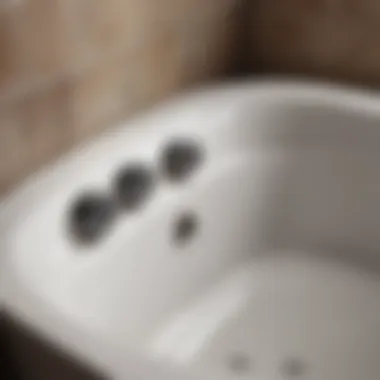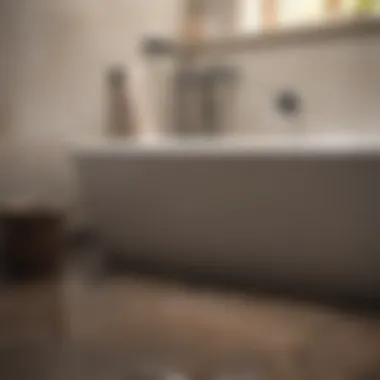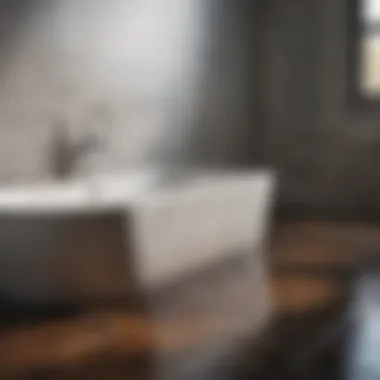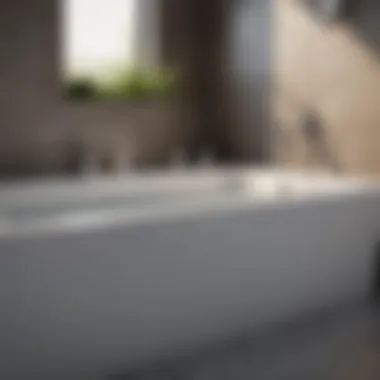Understanding Bathroom Tub Drains: A Comprehensive Guide


Intro
Bathroom tub drains might not seem like a focal point upon first glance, yet they play a pivotal role in ensuring that your bathing experience remains pleasant and clean. For many homeowners and design enthusiasts, understanding the intricacies of these systems can provide insights not only into their functionality but also into how they can complement a bathroom's overall aesthetic.
This guide unpacks the complex world of bathroom tub drains, discussing the various types available, their unique purposes, widespread issues, and a thorough maintenance strategy. As we wade through these topics, keep in mind the importance of choosing the right drainage system. After all, even the most beautifully designed space can fall short if the plumbing isn’t functioning properly.
In this journey, homeowners, designers, party hosts, and gardening aficionados will find practical tips alongside innovative design inspiration, transforming their bathrooms into havens of relaxation while ensuring they’re equipped for everyday functionality. Let’s dive deeper into what makes tub drains significant to your home.
Foreword to Bathroom Tub Drains
Bathroom tub drains might seem like a small part of your home, yet they play a pivotal role in the overall functionality of a bathroom. Taking the time to understand them is not just for the plumbing aficionados. It's essential for homeowners, interior design enthusiasts, and anyone keen on maintaining a well-functioning living space. A well-thought-out drainage system keeps water flowing out, preventing unsightly puddles and even more serious water damage.
Importance of Efficient Drainage
Imagine stepping into your beautifully designed bathroom, only to find water pooling around your feet because the drain is struggling to keep up. Efficient drainage couldn't be more crucial in such scenarios. Properly functioning drains ensure that unpleasant odors are kept at bay and that the bathroom remains a hygienic environment. Not only that, but good drainage can also save you from hefty repair bills arising from leaks or water damage down the line. Investing in a robust drain system contributes not only to your comfort but also to maintaining property value.
Overview of Common Drain Types
When it comes to tub drains, there's a smorgasbord of choices available, each with its own set of features. Here’s a quick breakdown of some popular types:
- Standard Tub Drains
The most traditional option, known for their simplicity and reliability. - Pop-Up Drain Mechanisms
These provide a user-friendly way to drain water with the push of a lever or knob. - Lift-and-Turn Drains
A twist to open or close, they need to be lifted to allow water to pass through. - Toe-Touch and Trip Lever Drains
These offer other styles of operation, either through foot pressure or a lever on the tub’s overflow.
Each variant has pros and cons that can affect your bathroom's functionality and aesthetic appeal. Therefore, understanding these options can help you create a bathroom that's both practical and stylish.
Types of Bathroom Tub Drains
To fully appreciate the intricacies of bathroom tub drains, one must first understand the various types available. Each type serves its own unique function, bringing about specific advantages that cater to different needs. The choice of drain can seemingly be a minor detail, yet it plays a vital role in the overall efficiency and functionality of the bathroom space.
Standard Tub Drains
Standard tub drains are often the unsung heroes of bathroom plumbing systems. This type generally includes a simple drain assembly situated at the bottom of the tub. Water flows freely from the tub through this opening while a strainer typically covers the top to catch hair and debris, helping to prevent clogs. Users need to keep an eye on the strainer, as regular cleaning can be necessary to maintain its effectiveness.
What many don't realize is that opting for a standard drain can offer economic benefits as well. They are usually more affordable, and installation tends to be relatively straightforward compared to more complex mechanisms. Furthermore, these drains work well with a variety of tub styles and materials, making them versatile for any bathroom setting.
Pop-Up Drain Mechanisms
Pop-up drains add a touch of convenience to the bathroom experience. They are designed with a stopper that can be easily lifted or lowered; typically managed by a lever or a pull cord. When one pulls or pushes the mechanism, the stop works in unison, allowing the user to fill the tub with water or let it flow down the drain accordingly.
One of the key reasons homeowners often prefer pop-up drains is the ease of use. They not only simplify the process of water control but also lend a sleek look to the overall design of the bathtub. However, it is essential to consider that these mechanisms may require occasional maintenance to ensure they operate smoothly, as parts can wear over time.
Lift-and-Turn Drains
The lift-and-turn drains stand out for their simplicity and practicality. This type requires the user to lift the knob located at the top of the drain and turn it to engage or disengage the stopper. It’s a no-frills approach that generally provides reliable performance without the complications of more advanced mechanisms.
Many favor lift-and-turn drains for their straightforward operation. Additionally, they often come with a compact design that integrates well with various tub styles, freeing up visual space. Regular maintenance is usually a breeze, mostly needing just a bit of cleaning to ensure optimal operation.
Toe-Touch and Trip Lever Drains
Toe-touch and trip lever drains offer unique functionalities, making them appealing options for those who want something a bit different. The toe-touch type allows users to open and close the drain using their foot, promoting hands-free use. Conversely, the trip lever drain typically features a lever, often mounted on the overflow plate, that controls the stopper's position.
These drains can set a bathroom apart, combining functionality with user-friendly features. That said, they may require more effort in terms of maintenance. Users should be prepared to occasionally check for debris build-up or potential malfunctions, as this can be a common issue with any drain that includes moving parts.


"Investing in the right bathroom tub drain can significantly improve your experience and efficiency, saving you time and potentially money in repairs down the line."
As we can see, each type of drain has its own qualities, catering to various preferences and requirements. Overall, understanding these different kinds can help homeowners and design enthusiasts make informed decisions when renovating or building a bathroom.
Understanding Drain Functionality
Understanding how bathroom tub drains work is essential for homeowners and anyone interested in interior design. An effective drain system not only enhances the convenience of bathing but also minimizes potential water damage. This section aims to demystify the process behind drain functionality and the vital roles that various components play in this system. It’s about ensuring that water flows smoothly and efficiently away from your tub—something most don’t think about until there’s a problem.
How Water Flows Through a Tub Drain
Water flow in a tub drain follows a simple principle: gravity. But there are a few more twists to it. When you fill up your tub, that water sits until you decide to let it out. Once you pull the drain plug, the water moves through a specified path leading to the house’s drainage system.
For a standard tub drain, the water first passes through the drain opening located at the bottom of the tub. From there, it enters the waste pipe. The angle of your plumbing is crucial—too flat and the water will just sit there, creating potential for clogs. The pipes should ideally slope downwards to ensure that gravity assists in moving the water.
Notably, the average bathtub can hold anywhere from 40 to 80 gallons of water. So when you consider the volume, it's easy to see why a proper draining system is crucial.
- Water enters the tub's drain opening.
- Flows through the waste pipe.
- Gravity guides the flow towards a main drainage system.
"An efficient drain system is as integral to a bathroom design as the fixtures themselves."
It's worth noting that kitchen and bathroom drainage may not always function in the same way due to the presence of various factors like food debris, soap scum, and hair in the bathroom. Awareness of these factors can help keep drainage problems at bay.
The Role of Traps in Drain Systems
If you think of a bathtub drain as a human body, then the trap could be considered its safety net. This part of the plumbing system, usually made of PVC or metal, serves an important function: it prevents sewer gases from entering your home. Traps retain a small amount of water, creating a seal that blocks odors from traveling back up the pipe.
Traps come in various forms, with the most common ones being the P-trap and S-trap. In a P-trap system, the pipe curves downward and then back up again, allowing water to sit in the bend. This design effectively keeps the bad smells at bay while also facilitating wastewater flow.
Benefits of having a well-functioning trap:
- Prevents unpleasant odors from creeping into your bathroom.
- Helps to catch debris that might clog the drain.
- Reduces the chances of serious plumbing issues down the line.
Importantly, regular maintenance is required to ensure that the traps do not become clogged with hair or soap scum, which can limit their effectiveness.
By understanding the functionality and the components that allow your bathtub to drain properly, you empower yourself to make informed decisions regarding maintenance and any necessary upgrades to enhance the utility of your bathroom.
Common Issues with Tub Drains
Understanding common issues with tub drains is essential for any homeowner or design enthusiast. Recognizing these problems early can save time, money, and a great deal of inconvenience. Drain systems are hidden fixtures that perform a critical role; when they go haywire, it can lead to not only disruption in everyday life but can also impact the aesthetics of your bathroom. Moreover, well-maintained drains can extend the lifespan of your plumbing system, making it worthwhile to delve into the main concerns that often plague tub drainage.
Clogs and Obstructions
Clogs are perhaps the most frequent headache when it comes to bathroom tub drains. Hair strands, soap residue, and various debris can accumulate over time, forming a stubborn blockage. It’s not just an annoyance, it can also impede the flow of water, resulting in slow drainage or, worse, water pooling in the tub.
Some tell-tale signs of a clog might include:
- Water that drains slowly or not at all
- Foul odors emanating from the drain
- Gurgling noises when draining water
To tackle this, regular maintenance is key. You can use a simple mixture of baking soda and vinegar as a natural remedy for light clogs. Pour the baking soda down the drain, followed by vinegar, and let it fizz for a few minutes before flushing with hot water. For tougher clogs, a plunger or a drain snake may be necessary. Remember, the goal is to keep water moving smoothly and avoid letting debris build up.
Leaking Drainage Systems
Leaks in the drainage system can lead to significant damage if not addressed promptly. The moisture can seep into walls, mold can grow, creating not just a damage issue but a health concern as well.


Leaking often occurs where joints or seals are present. If you notice water pooling around the drain or water stains on ceilings beneath, it’s time to take action. Regularly inspecting the under-sink plumbing components is advisable.
To remedy leaks, ensure:
- Gaskets and washers in the bathtub’s plumbing are intact
- All joints are properly sealed
- There isn’t visible corrosion that might indicate a deeper problem
If you’re not comfortable doing these checks yourself, don’t hesitate to call a professional. It’s better to catch these issues earlier rather than let them fester.
Corrosion and Material Degradation
Corrosion can be the silent killer of a tub drainage system. Over time, materials commonly used in plumbing, like metal and certain plastics, may deteriorate due to the constant exposure to moisture and chemicals. This can lead to leaks or, even worse, total system failure.
Common indicators of corrosion include:
- Visible corrosion or rust around fittings
- Flaking paint or plastic around the drain
- Strange metallic odors
Using high-quality materials during installation is crucial. Opting for corrosion-resistant options like PVC or stainless steel can save you from future headaches. Additionally, water softeners can be used if hard water is a concern in your area, as they reduce corrosion and buildup in plumbing. It’s important to stay vigilant, as catching signs of wear can aid in preserving the life of your tub drain system.
"A stitch in time saves nine" is particularly fitting when discussing maintenance; catching issues early can prevent them from evolving into more significant problems.
Maintenance Strategies for Tub Drains
Proper maintenance of tub drains is crucial in ensuring their longevity and functionality. A well-maintained drain not only prevents costly repairs in the long run but also enhances the overall bathing experience. By adopting consistent maintenance strategies, homeowners can significantly reduce issues such as clogs and leaks, ultimately bringing efficiency to any bathroom.
Routine Cleaning and Upkeep
Routine cleaning is the backbone of effective drain maintenance. Keeping the drain clear from hair, soap residue, and other debris can make a world of difference. Small items, like hair strands, may seem insignificant, but they can accumulate over time and lead to those pesky clogs. Regular use of a mesh strainer can be beneficial to catch hair and larger particles before they even reach the drain.
Here are some simple yet effective steps to consider for regular upkeep:
- Weekly Cleaning: Use a mild drain cleaner or a natural solution like baking soda and vinegar to flush the drain.
- Inspect the Strainer: Check and clean the strainer on a weekly basis, ensuring it’s not obstructed by debris.
- Physical Removal: For tough clogs, consider using a drain snake or even your fingers (if possible) to gently pull out caught hair and other obstructions.
Not only does this routine help prevent build-up, but it also keeps unpleasant odors at bay. After all, no one likes a stinky bathroom!
Using Eco-Friendly Solutions
For those who are environmentally conscious, there are a variety of eco-friendly solutions that can keep drains clean without harming the environment. Traditional chemical drain cleaners often contain harsh substances that can damage pipes and pose risks to aquatic life. Instead, consider using natural options:
- Baking Soda and Vinegar: This classic combination works wonders. Pour half a cup of baking soda down the drain, followed by half a cup of vinegar. Let it sit for about 30 minutes, then flush with hot water.
- Salt and Lemon Juice: Mixing salt with lemon juice creates a powerful cleaner. The acidity of lemon juice combined with the abrasiveness of salt helps in breaking down clogs and stains.
- Boiling Water: Pouring boiling water down the drain can help dissolve grease and soap build-up.
Monitoring how these eco-friendly methods perform in your tub drain will not only contribute to a sustainable lifestyle but also reflect a commitment to taking care of your home in a thoughtful manner.
"Taking care of your tub drain is not just a chore; it’s a step towards a healthier living environment."
By implementing these maintenance strategies, you have the ability to ensure that your tub drains function smoothly and efficiently, prolonging their lifespan and maintaining a clean and pleasant bathroom atmosphere.
Enhancing Bathroom Design with Drain Considerations
Designing a bathroom involves careful thought about many elements, and drains are often overlooked. However, these functional components play a crucial role in both aesthetics and practicality of the space. When keen attention is paid to how drains integrate with overall design, the result is not just a room that looks good but one that functions efficiently while also reflecting personal style.
Choosing Drain Styles to Match Aesthetics
The choice of drain style can greatly influence the visual appeal of a bathroom. Drains come in a variety of designs, which can either blend seamlessly into the decor or stand out as a distinctive feature. Here are a few styles to consider:


- Traditional grates: These can bring a classic feel to the bathroom. Materials like brushed nickel or bronze can add warmth and richness.
- Linear drains: These are not only modern but also help in maintaining a clean and sleek appearance, especially in larger spaces. They fit into the tiling beautifully, offering a contemporary look.
- Decorative drains: For those with a creative streak, there are drains in quirky shapes and colors which can transform an otherwise mundane component into a talking point.
This meticulous selection of drain styles ensures that functionality doesn’t compromise design. Consider the overall theme of your bathroom before making your selection, as mismatched styles can create dissonance.
Integrating Drains with Tile Work
Integrating drains into tiling is a splendid way to enhance the bathroom's visual harmony. When the drainage system works hand-in-hand with the tile layout, the results can be stunning. Here's how to achieve that:
- Choose compatible tile sizes: Ensure that the drain complements the tile size; for instance, a linear drain paired with large format tiles can create a uniform look.
- Color coordination: Match the drain color to the grout or the tile to make the drain almost disappear or vice versa for a bold statement.
- Strategic placement: Position the drain where the water flow is most prevalent, allowing for optimum efficiency while still framing it within stylish borders of your chosen tile.
Making these choices not only streamlines water flow but elevates the entire bathroom design, showcasing how function and aesthetics can dance in perfect harmony.
"A well-designed bathroom isn’t just about luxury; it's about creating a space that feels right. The details, like drains, can make all the difference."
By putting thought into drain considerations, homeowners can create a bathroom that not only serves its purpose but also becomes a sanctuary where design speaks volumes.
Technological Advances in Drain Designs
As the world embraces innovation, it’s essential for areas like bathroom designs to keep pace, particularly with something as crucial as drain systems. Embracing modernization in drain designs not only resolves existing problems but also enhances the overall user experience. With the growing emphasis on efficiency concerning water use, functionality, and aesthetics, savvy homeowners and design enthusiasts must understand the implications of these advances.
Smart Drainage Systems
The concept of smart drainage systems is gaining traction in modern bathrooms. Imagine having a system equipped with sensors that monitor the water flow and identify clogs before they become a full-blown disaster. Smart drains can connect to your mobile device, sending alerts about irregularities in drainage or even potential leaks. This kind of proactive management can save homeowners from costly repairs.
- Benefits of smart drains include:
- Real-time monitoring: Elevates awareness about drainage issues.
- Remote alerts: Can help you take swift action, avoiding catastrophic water damage.
- Automated control: Some systems offer features like automated flushing and cleaning cycles for maintenance.
Moreover, integrating smart technology into drainage systems may help optimize water usage, an essential step in the era of sustainable design. This not only serves the individual homeowner but contributes positively to our overall environmental footprint.
Innovative Materials and Their Benefits
Drain systems are no longer just about metal and PVC. The advent of innovative materials has transformed the market, offering durability and convenience. Materials like composite plastics or even bio-based products are now finding their way into drainage systems, bringing several advantages:
- Corrosion Resistance: Many new materials withstand corrosion better than traditional metals, extending the drain’s lifespan.
- Enhanced Flexibility: Lightweight yet strong, innovative materials can be molded to fit complex designs without compromising strength.
- Sustainability: Some contemporary materials are recyclable or produced from renewable resources, aligning with eco-conscious values.
"In the age where aesthetics meets functionality, innovative materials are shaping a new perspective on bathroom design."
This evolution in materials not only caters to practical needs but also allows for greater creativity in design. Homeowners can now choose drains that complement their overall bathroom theme while ensuring them a hassle-free experience.
In summary, the technological advances in drain designs mark a pivotal shift towards smarter, more efficient, and eco-friendly solutions. Understanding these elements helps homeowners make informed choices, enhancing both their living spaces and their investment in home improvement.
Epilogue
In wrapping up our exploration of bathroom tub drains, it's essential to underscore the significance of understanding these systems. Not only do they play a pivotal role in maintaining the functionality of your bathroom, but they also contribute to the overall aesthetic of your space. A thoughtfully chosen and well-maintained tub drain not only prevents issues like clogs and leaks but enhances the visual appeal of your bathroom, bringing harmony to your design vision.
Recap of Key Points
- Types of Drains: We delved into various types of drains, such as standard, pop-up, lift-and-turn, and toe-touch drains, each serving distinct purposes in terms of functionality and user convenience.
- Functionality: Understanding how water flows through the tub drain and the essential role traps play in drain systems is crucial for effective usage and maintenance.
- Common Issues: We highlighted prevalent issues faced with tub drains like clogs, leaks, and corrosion, emphasizing the importance of regular checks and maintenance.
- Maintenance: Simple maintenance strategies can prolong the life of your drains, including routine cleaning and the use of eco-friendly solutions to prevent blockages.
- Design Considerations: Choosing drain styles that fit the aesthetic of your bathroom not only improves space usage but also contributes to a polished look.
- Advances in Technology: The discussion of smart drainage systems and innovative materials showcases how advancements can improve the efficiency and functionality of your existing systems.
Final Thoughts on Tub Drain Importance
The importance of tub drains can't be overstated; they are the unsung heroes of the bathroom. They ensure your space functions properly while complementing the overall design. A well-functioning drain not only keeps your water flowing smoothly but also protects your investment in your bathroom’s design. Homeowners should be proactive, taking the time to learn about their drain options and how to maintain them effectively.
"An ounce of prevention is worth a pound of cure." This old adage rings true, especially in home maintenance. Investing a bit of time and effort into understanding and caring for your tub drain can save you from significant troubles down the line, creating a serene and efficient bathing experience.
Ultimately, an informed homeowner is better equipped to make decisions that preserve and enhance their environment. Familiarity with tub drains empowers you to tackle minor problems before they escalate, ensuring that your bathroom remains a refuge rather than a source of stress.
Be it through embracing technology or sticking to traditional methods, mastering the intricacies of your tub drain can transform your experience with this essential fixture. This commitment not only enriches your daily life but also safeguards your property value—a win-win situation in anyone's book.















